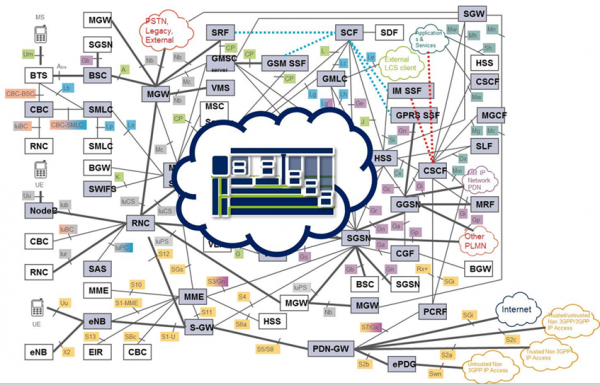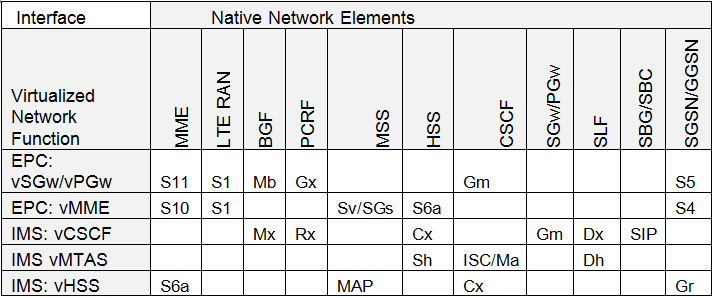This is an old revision of the document!
OPNFV Project Proposal: Carrier Grade Requirements for Network Transformation
Version: 0.1 (Jan 22, 2015)
Project Name:
Codename: Transformer
Descriptive name: Carrier Grade Requirements for Network Transformation
Project Categories:
- Integration & Testing
Project Description
The Transformer project aims at interoperability, functionality and performance testing of selected, important VNFs for a mixed physical NF (PNF) and VNF environment as typically found in service provider networks based on 3GPP standards. Interoperability and functionality testing shall be possible with minimal configuration following a sandbox approach using protocol analyzers on the relevant interconnection points based on standardized interfaces to the native network elements.
The implementation and integration of Cloud solutions in 3GPP based telecom networks is - in majority of cases - expected to be done in a step-wise approach. New NVFI/VNF elements will be introduced into the existing network architecture and will have to co-exist, integrate and interwork with existing native, in many cases physical Network Elements.
Knowing this, there is a requirement to secure interoperability on the “vertical” domain (like NFVI interoperability to VNF) and on the “horizontal” domain (i.e. between network functions, either virtualized or native). Last but not least interoperability to the devices and applications using the network functions is also required to ensure end-user experience.
The figure below illustrates the coexistence of virtualized infrastructure in a native 3GPP based network environment. This shows a typical scenario during the transformation phase towards a virtualized telecom network.
Since the transformation of networks towards a fully virtualized environment will take a long time mixed deployments will be a reality for the years to come.
During Network Transformation service provider requirements with regard to overall network performance and NF characteristics with regard to e.g. latency or high availability (99.999%) have to be met.
To ensure the service quality and network performance additional testing of NFVI and VNFs in a mixed native/physical and virtual environment should be considered. Existing OPNFV projects address testing in a pure virtual environment only.
“Transformer” aims at complementing these projects to assess carrier grade characteristics for mixed environments during network transformation.
Scope
From Testing and Performance perspectives, there are three main levels of testing and validations to be considered:
1. Interworking 2. Functionality 3. Performance
The stability and correct interworking on the interfaces is the foundation for interoperability while the balanced and aligned setting of parameters in the involved network elements will be crucial to obtain the optimal performance.
The interworking and functionality testing shall be run as the base prior to performance testing, if possible with a minimal configuration/Sandbox approach and protocol analyzers on the relevant interconnection points based on standardized interfaces to the native network elements.
It is obvious, that the large number of open & standardized interfaces in telecommunication networks lead to a big range of possible configurations of (multivendor) network solutions, including virtualized and non-virtualized elements.
Since the potential full scope of work covering the complete Telecom domain would be very broad and not feasible to be handled in this project, it is recommended to look at selected VNF use cases only.
As an example, the table below provides an overview of horizontal integration points of typical EPC and IMS related VNFs towards native Network Elements:
It is also proposed to start with the interworking and functionality testing prior to performance testing since this will limit the requirements on the lab environment with regard to capacity and redundancy.
Documentation
Requirement Definition
Per VNF a requirement sheet about the high level scope for the interworking, functionality and performance testing will be defined. Each requirement sheet will be stored as separate file.
Example: Overview of requirements defined for vCSCF:
1. (3GPP) Interoperability testing (incl. Cx interface to HSS, Gi interface to GGSN, Rx interface to PCRF, Dx interface to SLF, Mw interface to CSCF and SGW, etc.) 2. Functionality testing CSCF (incl. typical acceptance test cases to prove that all functionality of the application is covered) 3. Performance Testing CSCF (incl. Redundancy, Load balance, Reliability, Stress & Negative testing, etc.)
Dependencies
Other Test and Performance Projects & Proposals
- Virtualized Infrastructure Deployment Policies (“Copper”)
- High Availability for VNFs
- Testbed Infrastructure (Pharos)
- Base System Functionality Testing
Committers and Contributors
Committers:
- Michael Wiegers (michael.wiegers@ericsson.com)
- Chitti Nimmagadda (Chitti.Nimmagadda@ericsson.com)
Contributors:
Planned Deliverables
Propose to start with the interworking and functionality testing prior to performance testing with minimal configuration/Sandbox approach with protocol analyzers.
Proposed Release Schedule
To be aligned with the first OPNFV reference platform release planned.
References
1. ETSI NFV ISG Portal 2. ETSI GS NFV 001 V1.1.1: Network Function Virtualization; Use cases


